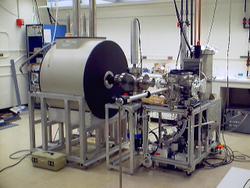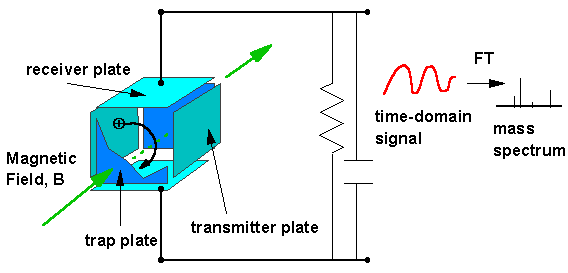 |
 |
 |
 |
 |

 |
Ion cyclotron resonance can be explained using two simple physics principles. Trapped ions move in a circular path along the magnetic field line. This is called the magnetron motion. The working equation for ion cyclotron resonance can be derived by equating the centripetal force and the Lorentz force experienced by an ion in a magnetic field and then solving for angular frequency:
mv2/r = evB |
As you can see from the above equation, a group of trapped ions with the same mass-to-charge ratio will have the same cyclotron frequency but are in a statistically random distribution. If a rapid frequency sweep (chirp) is introduced into the measuring chamber, each ion will absorb energy at their specific cyclotron frequency. This added energy causes the size of that ion's orbit to increase as it resonantly amplifies its cyclotron motion. The cyclotron motion establishes discrete coherent packetsof ions with identical mass and thereby provides a means to selectively separate one mass from another. Ions resonating and moving in a cyclotron motion are measured using plates that detect an induced image current. A Fourier transform is used to convert a time domain signal (image current) to a frequency domain spectrum (mass spectrum).
One of the biggest advantages of FT-ICR-MS is its unparalleled mass resolution. Mass measurements can be made on highly complex chemical or biological samples, without the need for any separation method, such as gas or liquid chromatography. Also, the mass determination can be made to a minimum of 3 significant figures past the decimal point (if not more) by performing accurate mass measurements using an internal calibration. With this kind of accuracy, it is possible to determine the identity of unknowns based simply on mass. Another unique feature of FT-ICR-MS is the control of stored ions within the ion trap.
